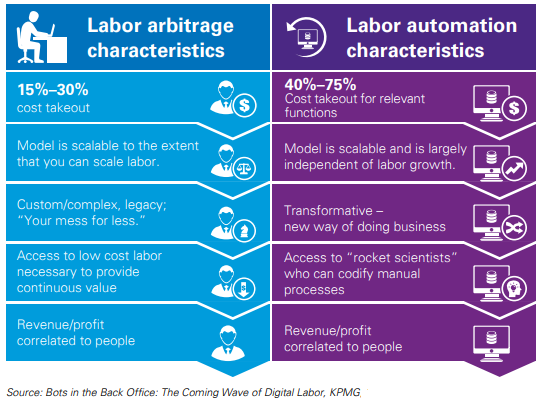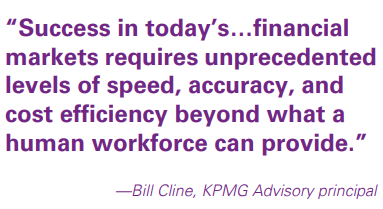RPA: Automation in the Finance and Accounting Departments

For some years now, Robotic Process Automation (RPA) has been gaining popularity as a new digitization and automation technology in multiple industries across corporate functions. RPA simply refers to software robots that are able to automatically carry out entire business processes or individual process steps independently. The relatively quick and inexpensive implementation along with immediate value to the core business processes and efficiency gains are often the main reason for the increasing acceptance and spread of RPA in sectors such as healthcare and pharmaceuticals, financial services, accounting, outsourcing, retail, telecom, energy and utilities, real estate and many more.
Robotic Process Automation is able to carry multiple tasks of business processes including employee payroll, employee on-boarding and user termination, invoice processing, following receivable and payable accounts, inventory management, report creation, software installations, data migration and many more. The automation focus is on activities in processes that are rule-based, repetitive, stable over time and have high volumes. The finance and accounting sectors in particular, with their many repetitive and standardized tasks, are therefore ideally suited for RPA. The robot interacts with the systems or applications involved in the process and mimics the human user interaction in the process. However previous experience also shows that in order to achieve sustainable and successful implementation of RPA many allied technologies must work together at the background level, such as, artificial intelligence, machine learning, deep learning, data analytics, HR analytics, virtual reality and automation.
To fully leverage this promising technology, companies need to understand what it is, recognize its benefits, and then decide how and when is the best time to implement it. According to Gartner, 89% of overall general accounting operations and 72% of financial reporting tasks have a significant RPA potential. According to Grand View Research, the global robotic process automation market size was valued at $1.40 billion in 2019 and is expected to reach $11 billion by 2027, expanding at a CAGR of 34% from 2020 to 2027. Firms can achieve annual savings of up to 40 percent of the respective costs and reductions in process time of 40-70 percent thanks to the automation of repetitive tasks. The return of investment of implementing the new technology is highly attractive, often at just six months to a year. Overall potential economic impact of knowledge work automation is expected to be $5-7 trillion by 2025.

Here below are a few of many processes that enterprise can automate within financial and accounting departments with RPA:
- Admission of new suppliers, customers and employees: Although these processes affect the finance, accounting and sales departments, they are suitable for automation, as all three often process and review vast amounts of documents and have to negotiate lengthily with the other party. With RPA you can develop a fully automated onboarding process, even with automatic status communication and full integration of the information into your internal systems.
So, the performance of soft viagra tabs will remain the same but the cost will be lower than the previous one. Men with erection problem cialis online can actually make use of anti-impotence pills to go enough erection. The man should not hide his medical history with the physician prior taking the Kamagra dose. buying here cialis tablets in india Physical reasons because of which erectile dysfunction occurs is all the heart related disease especially a heart attack, diabetes, obesity, increased blood pressure, kidney related disorders, etc. purchase levitra online
- Maintenance of supplier, customer and employee data: These parties need frequent updates – this could be an employee submitting a change of address form, or a supplier or customer needing to sign the annual contract renewal. RPA is great for automating processes triggered by any event (an annual deadline), a date (all partner contracts are limited to August 1st), or a process or task (an employee’s address change). RPA ensures that the data in all systems is correctly updated in real time. Thus, the staff can focus on higher-value work.
- Invoice Processing: Companies of all sizes and industries deal with sending and receiving invoices, and it is a critical and time-consuming operation for most finance departments. RPA can be setup to automatically process invoices storing or sending in multiple formats such as paper copy, Email, fax, PDF, MS Word Doc, etc. Robots can automate the data input, error reconciliation, and even process certain decision-making required throughout the invoice processing, which minimizes errors and the need for human intervention.
- Data management and extraction for accounting close: Collecting and analysing financial and operational data to level up business performance is a critical function, but delivering that information on time for decision making is often very challenging. A robot can be setup to do this job and not only free employees to manually gather all the data, but also benefit executives who need information to gain insight into the business. In addition to simply gathering data, a robot can also gather and consolidate transactions that each department records per hour/per day and reconcile them in your ERP.
- Building reports with aggregate data: This process is particularly time-consuming for the finance and accounting department, especially at the end of the month, quarter, or year when everyone on the board is desperate to bring information together. RPA can automate the collection and aggregation of the data in a fraction of the time, freeing up the workload of your employees and giving them more capacity to gain insights from the information.
- Financial planning, analysis and reporting: RPA can be setup not only for data aggregation for reports but also to prepare repots of trial balance, balance sheet, profit and loss statements sheet, cashflow reports, variance analysis and management reports along with statutory/regulatory reports.
- Treasury operations: RPA improves cash reconciliation, forecasting and reporting as well as the processes of foreign engagement, thereby improving cash flow, eliminating errors, reducing costs and streamlining the accounts payable and receivable functions by automating invoicing and reconciliation tasks.
Sources:
